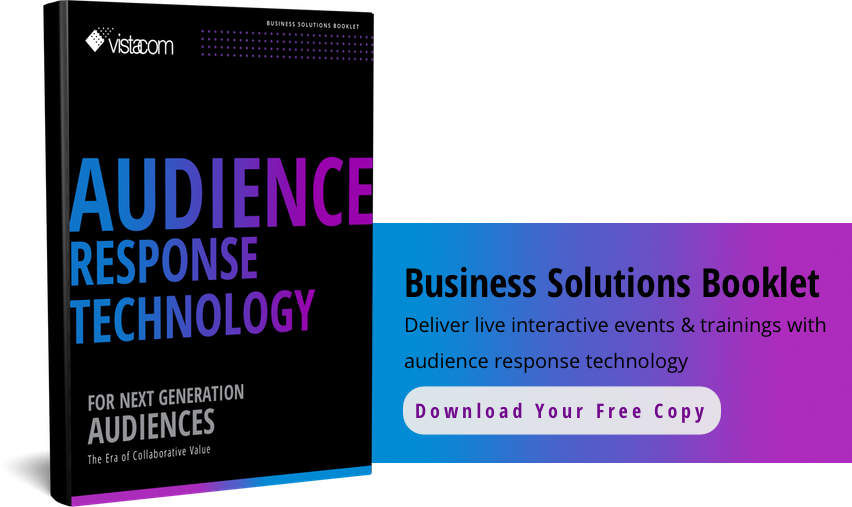Fact check your knowledge of audience response systems (ARS) as we continue to debunk outdated assumptions of ARS technology’s applicable use cases, functional capabilities and technical limitations.
Myth 1. Audience response systems only work for conferences and events
ARS technology is multi-faceted in nature. Beyond conferences and events, audience response supports businesses in boosting productivity and unlocking profit-generating data on customers and employees. Digital, mobile and keypad audience response solutions are increasingly being used for employee trainings, advisory board meetings, and departmental meetings.
Here are a select handful of business use cases for audience response:
- Employee training leaders can utilize audience response to collect employee feedback in real time and track learning progress with quizzes and open-ended Q&A.
- Managers can boost the productivity of all-hands meetings with ARS using real-time surveying, mobile polling and Q&A, and crowd upvoting.
- Employee feedback can be collected leading up to, during, and after important annual gatherings using audience response to conduct surveys, quizzes and polling.
Myth 2. Audience response can’t be accessed remotely
The most cutting-edge audience response systems are equipped with multiple connectivity options. Vistacom’s suite of audience response solutions can be deployed on Wi-Fi and cellular data networks, as well as local servers. Organizations that utilize ARS for major conference events attracting a blend of remote and in-person attendees typically take a hybrid approach.
Depending on hotel costs associated with providing attendees Wi-Fi access, conference organizers tend to deploy their ARS polls and surveys via local servers. Businesses using audience response year-round for board meetings and employee trainings often choose to rely on their office WiFi network.
Myth 3. ARS systems aren’t equipped for ballots
For organizations looking to transition from traditional paper ballots and scantron systems, audience response systems can be used to transition to a more advanced process of real-time electronic voting. Functioning as an electronic voting system, ARS eliminates the need for counting ballot submissions, checking for quorum, and manually updating ballot choices after each round of voting.
ARS systems streamline the voting process in the following ways:
- Voters are authenticated and weighting scores are applied in real time.
- Incoming votes can be hidden or displayed to participants in real time.
- Election organizers can monitor ballot participation, and access auto-generated reports throughout the voting process.Voters can engage in the voting process using their computer, mobile or tablet devices, or keypad devices provided by ballot organizers.
Myth 4. ARS systems don’t offer robust data analytics
Industry leading audience response systems make data collection, monitoring and analytics a seamless experience. Using web admin dashboards, organizations can access live reports on polls, surveys, quizzes, and Q&As that are deployed from ARS systems.
Easy-to-understand data visualizations containing charts and graphs are displayed in the web admin dashboard, and downloadable reports on critical data points are automatically generated. With online and offline data access options, organizational leaders find it much easier to monitor and identify data findings that can be applied to future business decisions.

